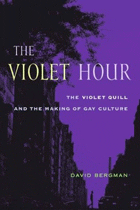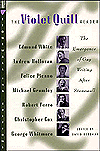 Gene
Hayworth reviews... Gene
Hayworth reviews... The
Violet Hour The
Violet Hourthe Violet Quill and the Making of Gay Culture by David Bergman |
BIO
Gene Hayworth grew up in North Carolina and attended undergraduate school at UNC - Greensboro. He worked for 10 years as a layout artist, technical writer, computer specialist and training instructor before returning to school at the University of Rochester, where he received a Masters degree in English with a concentration in creative writing, and an MLS from Syracuse University. He moved to Colorado in 1995 and worked at CARL Corporation for several years, and in the summer of 1999 he worked for CARL in Singapore, which resulted in the publication of an article about his experiences titled "Singapore Libraries Usher in a New Era," in Computers in Libraries, 20:6 (Nov./Dec. 2000). He is an avid reader and has written several book reviews for Colorado Libraries. In February 2003 he prepared an exhibit at the Fales Library, NYU, on the Gay American novelist and playwright Coleman Dowell. His critical study of Dowell appeared in The Review of Contemporary Fiction, Fall, 2002. Currently he works as a reference librarian for the University of Colorado at Boulder Libraries.
Gene Hayworth would like to hear from you about this review. If you are a writer or publisher with a literary offering or work of non-fiction, please contact Gene directly with your request for a review.

| Bergman, David The Violet Hour: the Violet Quill and the Making of Gay Culture Columbia University Press, 2004 ISBN 0-231-13051-1 304 pages, paperback $24.50  If you explore any library catalog for
materials listed under the terms "queer theory" or "gay and lesbian
literature," your research will likely result in hundreds of entries.
Gay and lesbian authors have made significant contributions to
literature and libraries have finally begun to recognize the importance
of collecting and offering this material to the public. Although many
critical studies address gay and lesbian literature, there have been
few that suggest there is a unified body of work within the community.
David Bergman's new book, The Violet
Hour: the Violet Quill and the Making of Gay Culture is unique
in this regard. Bergman, who also edited The Violet Quill Reader: the Emerging of
Gay Writing after Stonewall (1994), considers the seven
writers who comprised the literary group known as the Violet Quill.
Christopher Cox, Robert Ferro, Michael Grumley, Andrew Holleran, Felice
Picano, Edmund White, and George Whitmore, met for a very short period
in the early 1980s to share and discuss their works-in-progress.
Although these writers were at varying points in their careers, their
work reflected a common interest in exploring what it meant to be a gay
man in a society whose attitudes still reflected the events of WWII and
the McCarthy era. If you explore any library catalog for
materials listed under the terms "queer theory" or "gay and lesbian
literature," your research will likely result in hundreds of entries.
Gay and lesbian authors have made significant contributions to
literature and libraries have finally begun to recognize the importance
of collecting and offering this material to the public. Although many
critical studies address gay and lesbian literature, there have been
few that suggest there is a unified body of work within the community.
David Bergman's new book, The Violet
Hour: the Violet Quill and the Making of Gay Culture is unique
in this regard. Bergman, who also edited The Violet Quill Reader: the Emerging of
Gay Writing after Stonewall (1994), considers the seven
writers who comprised the literary group known as the Violet Quill.
Christopher Cox, Robert Ferro, Michael Grumley, Andrew Holleran, Felice
Picano, Edmund White, and George Whitmore, met for a very short period
in the early 1980s to share and discuss their works-in-progress.
Although these writers were at varying points in their careers, their
work reflected a common interest in exploring what it meant to be a gay
man in a society whose attitudes still reflected the events of WWII and
the McCarthy era. At the time of their brief convergence, these seven writers had already traveled many similar paths. With the exception of Picano, each of the authors came to New York after breaking all ties with their hometowns. The writers were highly influenced by a European tradition of literature that included authors such as Jean Genet and Christopher Isherwood, and rejected the gay literary history prevalent in the U.S. in the forties and fifties. In addition, these writers were interested in the social expectations of the gay novel, rejecting the medical view of homosexuality as a sickness and exploring homosexuality instead in terms of religion and morality. According to Bergman, their work shares several common features, among them a co-mingling of the sacred and profane, exploration of the erotic in Gay culture, use of autobiographical elements, and the representation of central characters who are often unlikable. Bergman's book is an interesting mix of literary scholarship and personal memoir. As the preeminent scholar of the Violet Quill he has formed close personal relationships with several of the group's members and his regard for them is clear in the way that he writes about his own interactions with them. Much of the book is biographical, addressing sexual exploits and the loss of virginity, but Bergman provides a detailed analysis to show how these experiences shaped the works of the Violet Quill. Perhaps most important is Bergman's ability to situate these writers in the larger historical context of Gay literature from 1940 until the present. Bergman examines the way these authors broke from tradition and he provides extensive examples to support his analyses. Before Stonewall the gay novel had aimed to "create sympathy for homosexuality," and it was this attitude that the Violet Quill rejected. Several chapters examine specific correlation between the writers, such as the journeys they took to New York and Europe, and the effect that those journeys had on works like White's The Farewell Symphony and Ferro and Grumley's non-fiction work, Atlantis: the Autobiography of a Search. For some of the members of the group, the need to live in Europe was caused by a search for sexual expression and freedom from family, others sought experiences that could inspire fictional narratives. Like other writers who had gone to Europe before them, these adventures inspired them to examine the relationship between European and American culture. Because the members of the group were all white, questions of race in their work is problematic. A chapter on race and the Violet Quill examines Ferro and Grumley's sexual desire for black men and the interracial relationship in Holleran's Dancer from the Dance, Ferro's The Family of Max Desir, and Grumley's posthumously published novel, Life Drawing, works that shows links between sexual and racial oppression. Bergman also compares other important patterns in their works and lives, their views of homosexuality, their reactions to the gay liberation movement and to AIDS. Bergman's admirable book has been issued as part of Columbia's "Between Men / Between Women" series in Lesbian, Gay, and Bisexual studies, which provides a forum for lesbian and gay scholarship and humanities and social sciences. Other books in the series include The Columbia Anthology of Gay Literature, edited by R.S. Byrne, and Hear Us Out: Conversations with Gay Novelists, conducted by Richard Canning. |